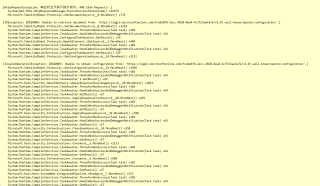#.net MVC4 使用AAD登录, 更改了Tenant 为租户ID, 因为应用程序里更改了受支持的帐户类型为仅我的组织

startup.cs代码如下
public class Startup
{
// The Client ID is used by the application to uniquely identify itself to Microsoft identity platform.
string clientId = System.Configuration.ConfigurationManager.AppSettings["ClientId"];
// RedirectUri is the URL where the user will be redirected to after they sign in.
string redirectUri = System.Configuration.ConfigurationManager.AppSettings["RedirectUri"];
// Tenant is the tenant ID (e.g. contoso.onmicrosoft.com, or 'common' for multi-tenant)
static string tenant = System.Configuration.ConfigurationManager.AppSettings["Tenant"];
// Authority is the URL for authority, composed of the Microsoft identity platform and the tenant name (e.g. https://login.microsoftonline.com/contoso.onmicrosoft.com/v2.0)
string authority = String.Format(System.Globalization.CultureInfo.InvariantCulture, System.Configuration.ConfigurationManager.AppSettings["Authority"], tenant);
// ADFS
string FederationMetadata = System.Configuration.ConfigurationManager.AppSettings["FederationMetadata"];
string Realm = System.Configuration.ConfigurationManager.AppSettings["Realm"];
/// <summary>
/// Configure OWIN to use OpenIdConnect
/// </summary>
/// <param name="app"></param>
public void Configuration(IAppBuilder app)
{
IdentityModelEventSource.ShowPII = true;
app.SetDefaultSignInAsAuthenticationType(CookieAuthenticationDefaults.AuthenticationType);
app.UseCookieAuthentication(new CookieAuthenticationOptions
{
CookieManager = new SystemWebCookieManager()
});
app.UseWsFederationAuthentication(
new WsFederationAuthenticationOptions
{
MetadataAddress = FederationMetadata,
Wtrealm = Realm
//RequireHttpsMetadata = false
});
app.UseOpenIdConnectAuthentication(
new OpenIdConnectAuthenticationOptions
{
// Sets the ClientId, authority, RedirectUri as obtained from web.config
ClientId = clientId,
Authority = authority,
RedirectUri = redirectUri,
// PostLogoutRedirectUri is the page that users will be redirected to after sign-out. In this case, it is using the home page
PostLogoutRedirectUri = redirectUri,
Scope = OpenIdConnectScope.OpenIdProfile,
// ResponseType is set to request the code id_token - which contains basic information about the signed-in user
ResponseType = OpenIdConnectResponseType.CodeIdToken,
// ValidateIssuer set to false to allow personal and work accounts from any organization to sign in to your application
// To only allow users from a single organizations, set ValidateIssuer to true and 'tenant' setting in web.config to the tenant name
// To allow users from only a list of specific organizations, set ValidateIssuer to true and use ValidIssuers parameter
TokenValidationParameters = new TokenValidationParameters()
{
ValidateIssuer = true, // This is a simplification
ValidIssuer = authority
},
// OpenIdConnectAuthenticationNotifications configures OWIN to send notification of failed authentications to OnAuthenticationFailed method
Notifications = new OpenIdConnectAuthenticationNotifications
{
AuthenticationFailed = OnAuthenticationFailed
}
}
);
}
/// <summary>
/// Handle failed authentication requests by redirecting the user to the home page with an error in the query string
/// </summary>
/// <param name="context"></param>
/// <returns></returns>
private Task OnAuthenticationFailed(AuthenticationFailedNotification<OpenIdConnectMessage, OpenIdConnectAuthenticationOptions> context)
{
context.HandleResponse();
context.Response.Redirect("/register/login/?errormessage=" + context.Exception.Message);
return Task.FromResult(0);
}
}
执行跳转页面的代码
public void SignIn()
{
if (!Request.IsAuthenticated)
{
HttpContext.GetOwinContext().Authentication.Challenge(
new AuthenticationProperties { RedirectUri = "/" },
OpenIdConnectAuthenticationDefaults.AuthenticationType);
}
}
执行跳转后报错

但是里面的url是可以访问的

求解!
